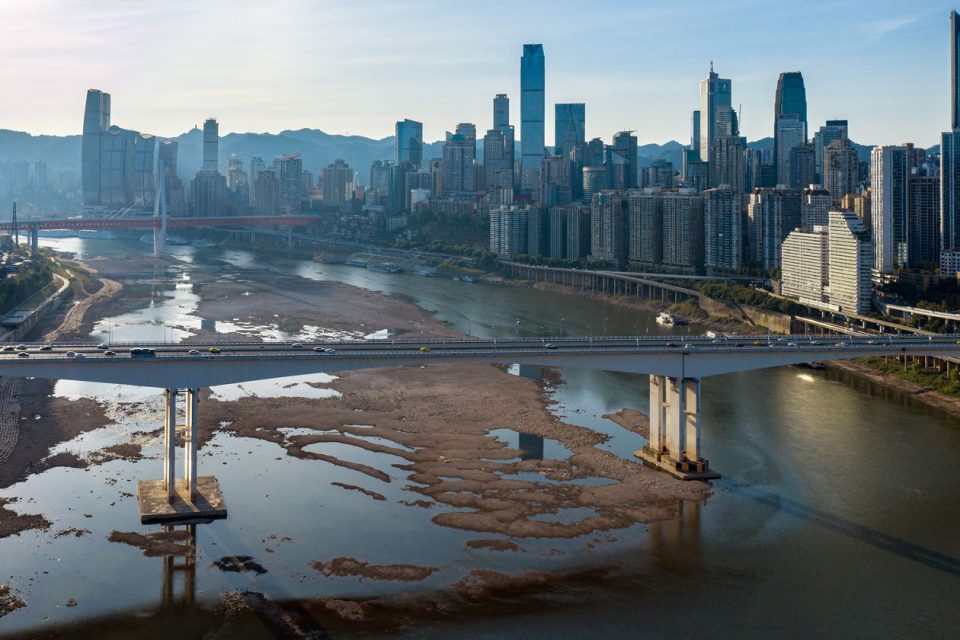las scorching hot converted into China In a furnace this summer, with a profound impact on the industrial powerhouse, which could be a foreshadowing of how other changes from the climate crisis will affect factories around the world. The Asian giant now faces a new threat that could be devastating to an economy already hit by the pandemic and put even more strain on supply chains: The worst heat wave in the last 60 years.
The rivers have dried up and hydroelectric power is being supplied with them. Trying to turn on the lights, Provincial governments have asked factories to close.
Heart-wrenching pictures show Chongqing’s river gorges, once full of tourists, are now empty and have reached the gorges. In the city, the water level fell and 600-year-old Buddhist statues were submerged.
Thus, severe drought and high temperature have broken records in India Sichuan, a very important industrial enclave with a population of about 84 million inhabitants. According to provincial officials, The flow of hydroelectric dams has decreased by 50% compared to the historical average. As in the neighboring province of Hubei, where the Blue River at the outlet of the Three Gorges Dam, the world’s largest, has reduced significantly.
Yangtze 6,300 km. with the third longest river in the worldProvides drinking water to more than 400 million Chinese people and is the most important waterway for the Chinese economy. Its hydrographic basin covers an area of 1,800,000 km, seven times that of the United Kingdom. It is vital to the global supply chain. but this summer Its flow has reached a record level of water scarcityEntire stretches and dozens of tributaries are drying up.
Faced with a triple whammy of rising temperatures, high demand for air-conditioning, and low rainfall since records began in the 1960s, the Sichuan government, which generates 80% of its electricity from hydroelectricity, on August 21 set the highest level. Launched to guarantee emergency response. energy supply. in the last week, Ordered that companies operating in 19 out of 21 cities in the province temporarily paralyze their activities In favor of “people” power supplies over industrial users. that the province is a major exporter of energy supplies about a third of its hydroelectricity production to other regions during the rainy season, It is also a major production center for semiconductors and solar panels, and this electricity rationing has affected factories for some of the world’s largest electronics companies, such as Foxconn, a supplier to Apple and Intel.
impact on companies
In response to provincial demands for energy savings, Toyota has announced that it has temporarily closed its factory in Chengdu, the historic capital of Sichuan province, and suspended its operations until the end of August. Tesla and state-owned SAIC Motor have told the Shanghai government that they could have problems maintaining production if the power crisis at their suppliers continues to plague the city. Other affected automotive sectors are Geely Auto and Great Wall Motors as well as the chemical and fertilizer industries.
In return for electricity rationing Production interrupted at some twenty steelworkswhen Aluminum and zinc smelters have in turn reduced productionAccording to data provider Shanghai Metals Market.
Tongwei, the world’s largest supplier of polysilicon, has closed its main factories due to supply problems, so expect already high polysilicon prices to rise. This region is believed to be responsible for One-sixth of the total industrial output in the Asian giant. This material is also fundamental to the manufacture of solar panels, Manufacturers of these modules moved to the area to be closer to supply, and are now temporarily closing, including Ginkgo Solar, GCL Tech and Qingdao Gaos Technology.
The industrial heartland of China is also the center of extraction of lithium In the country, electric cars are a major component of batteries, so according to analysts, the stagnation could drive up raw material costs. The factories of China’s lithium battery company CATL have been affected. The company supplies many electronics industries such as Tesla and Schneider Electric.
AIDS
The world’s second largest economy, Red Hot, has reached 45 degrees in dozens of cities several times. in the southwest of the country, fierce fire They are eating the vegetation of the Chongqin Mountains. To cool the atmosphere and submerge crops, Beijing tries to control the sky and the weather by sending catalysts into the clouds.
In order to reduce losses in agriculture, the Chinese Ministry of Finance allocated in mid-August 300 million yuan (about 43 million euros) in aid to 13 provinces, The money will be used to buy seeds, pesticides and other materials, while Sichuan officials are also pushing for agricultural insurance to help farmers claim crop losses.
Acute drought has also affected at least 2.2 million hectares of agricultural land in Hebei, Hunan, Jiangxi, Anhui and Chongqing. in large quantity 780,000 people need this direct help from the government to deal with the situationAccording to the Ministry of Emergency Management of China. Drinking water has been moved to areas where residential supplies have been completely exhausted.
High temperatures in July alone caused direct economic losses of 2.73 billion yuan, affecting 5.5 million people, the emergency ministry reported last week.


